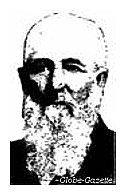
1876~ 100th Independence Day ~ Deacon J. G. Brown 
CLIGGITT, PARKER, GAYLORD, KEERL, SCHELL, THOMPSON, LOWN, BROWN
Posted By: Sharon R Becker (email)
Date: 11/18/2014 at 12:46:15
The Globe Gazette
Mason City, Cerro Gordo County, Iowa
Monday, June 01, 1953
Mason City Centennial Edition, Section 31876: CITY OBSERVES 100th INDEPENDENCE DAY
[Section 3, Page 15] The Spirit of '76 took possession of Mason City 77 years ago. The city staged a celebration that was remembered for years afterwards. There wasn't any queen, nor any parade of bands and floats.
visitors coming from surrounding farms and communities didn't find themselves in any heavy automobile traffic and they didn't scan the skies for airplanes.
It was on July 4, 1876, when the town joined with the nation to observe the 100th anniversary of its independence. The majority of visitors that came to Mason City to help the town's population of 1,200 celebrate the event were farmers with their families.
Rode in Wagon
They came mostly in wagons. Not one farmer in 50 had a buggy in 1876. Families were large and it took a wagon to hold them and the dinner basket and horse feed. They looked rather gay as they started out with spring seats for the older folks and a board with cleats to hold it in place for the children.The Northwood Band provided music for the day. Other surrounding communities helped with the day's program. S. P. Leland of Charles City, the stories have it, was the orator of the day. John Cliggitt read the Declaration of Independence. H. G. Parker as the historian.
A procession was formed in the morning and marched to a grove near Parker's Mill in Rock Glen, where a stand had been erected and the president of the day, C. M. Gaylord, welcomed the guests.
After an hour of oratory came dinner. In the afternoon those who liked ball games could see one, while those who preferred to dance enjoyed the bowery dance in progress all afternoon.
The crowd thinned out at "chore time" and an early account of the celebration states rain broke up the fireworks planned for the evening.
Other News Events
News events in 1876 include some interesting happenings. During the night of July 30, a thief stole one of Henry Keerl's horses and left for parts unknown. A reward of $125 was offered and Sheriff Schell started in hot pursuit, but the thief evidently became frightened and abandoned the horse about six miles south of Forest City.During a thunderstorm on Aug. 29, Frank Thompson's stable was struck by lightning and set on fire. Three horses and a colt were burned to death, while two horses broke loose and escaped.
On July 13 the small daughter of R. H. Lown of Clear Lake was fatally burned while attempting to light a fire with kerosene. She didn't think there was fire in the stove, so poured the oil out of the can and the can exploded, enveloping the girl in flames. Her 14-year-old sister tried to smother the flames, when her own clothes caught fire and she was serverely burned.
Custer Massacred
The big news item on the national scene that year was [the] massacre of Gen. George Armstrong Custer and 276 of his men on the Little Big Horn in Montana on June 25.That event marked the end of the bloody trail of the Sioux from the time they went westward from Iowa in the '50s. After [the] Little Big Horn battle the Indians were scattered and never again became a threat to the white man.
* * * * *
DEACON BROWN
[Section 3, Page 15] Deacon J. G. Brown was named the first superintendent of the Sunday School of the First Baptist Church at the organization in the old courthouse May 18, 1870. Sunday School sessions were held in downtown halls until the first church was built in 1876.
Deacon Brown photograph courtesy of Globe-Gazette
Transcriptions by Sharon R. Becker, November of 2014
Cerro Gordo Documents maintained by Lynn Diemer-Mathews.
WebBBS 4.33 Genealogy Modification Package by WebJourneymen